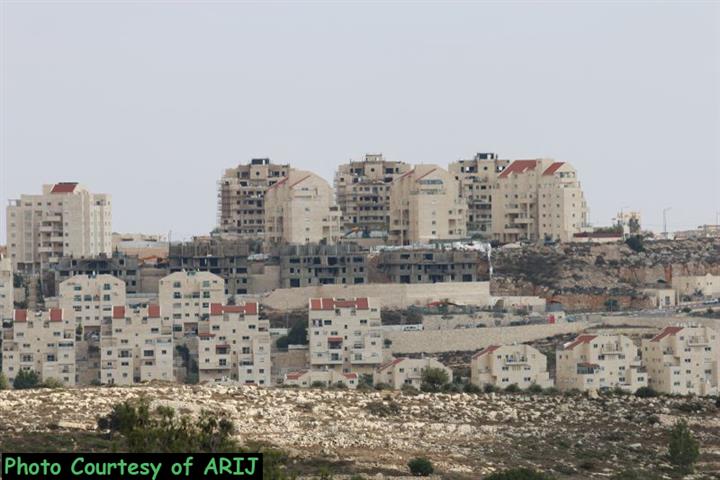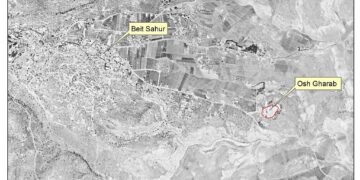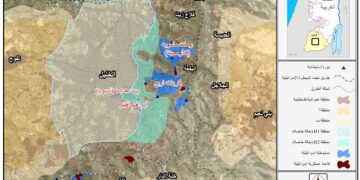What is so-called “Civil Administration Blue Line Team”, considering the allocation of +3700 dunums from the Palestinian lands to the interest of illegal settlements in the West Bank.
On the 9th of February 2015, the Israeli daily newspaper ‘Haaretz’ revealed in a report that the Israeli Civil Administration prepared major expansions of the settlements of; Kedumim, Vered Yericho (cooperative and agriculture settlement), Neveh Tzuf ( Hallamish) and Emanuel.
According to the report, some 3,740 dunums in the areas of the settlements were marked by the aforementioned (Blue Line Team) as “state lands”. Noted that more than 99% of State land are allocated to settlements.
Furthermore, the report provided that during the year 2014, the preparations for submitting construction plans were carried out on 18 project encompassing 12,840 dunums in comparison with 26,548 dunums for the year 2013. During the year 2014, preparations and planning for the construction plans were done in the illegal settlements of, Kiryat Arba, ‘Ateret, , Nokdim, Adora and Beit ‘Ayin West in addition to the outpost of the Ma’aleh Rehavam.
The report also indicated that there also has been a change in settlements’ areas of jurisdiction, Last year they increased by 1,162 dunums in total. The settlement of Pisagot north of Jerusalem received 155 dunums, Elkana settlement far west of Salfit received 904 dunums, and Mevo Horon north of Jerusalem 600 dunums.
Israel escalated its expropriation campaign especially for the pretext of declaring “state land” with deliberate concentration on the Palestinian-owned lands located nearby the illegal settlements.
Following are details about the changes in each settlement:-
The Israeli settlement of Kedumim:
Kedumim is an Israeli settlement established in 1975, on Palestinian land in Qalqilya Governorate. Currently, the settlement area reach to 765 dunums. In the year 2014, the Israeli Civil Administration planned to expand the settlement of Kedumim by allocating about 56 dunums around the settlement; classified as “State land”.
According to the new expansion plan, the Israeli Authorities will allocated about 92 dunums marked as “State land” to expand the settlement borders. Some of the area the Israeli Authorities claimed to be added to the settlement area is already used by the Israeli settlers, for agricultural purposes See map No.1 below:
Map 1: the Israeli settlement of Kedumim
The Israeli settlement of Vered Yericho:
Vered Yericho is an Israeli (cooperative agriculture) settlement established in 1980 on land expropriated from the Palestinian residents in Jericho governorate. The settlement occupied an area of 627 dunums of Palestinian land, however, the area of the master plan for the settlement reach to 1749 dunums. See map No.2 below:
Map 2: the Israeli settlement of Vered Yericho
The Israeli settlement of Neveh Tzuf “Hallamish”:
Hallamish , an illegal settlement in Ramallah Governorate. Established in 1977, and occupy an area of 674 dunums of Palestinian lands, while the area of the master plan of the settlement; issued by the Israeli Authorities in 1995, is 4034 dunums.
In 2014, the Israeli Civil Administration allocated 462 dunums of lands around the settlement, for the expansion and development of the settlement.
For the new expansion Plan approved by the Civil Administration, 2,061 dunums allocated for the expansion of the settlement of Hallamish. See map No.3 below:
Map3: the Israeli settlement of Hallamish
The Israeli settlement of Emanuel:
The Israeli settlement of Emanuel established in 1981 south east of Qalqilya Governorate. The total area of the settlement are 1,154 dunums. However, when the Israeli Authorities approved the master plans for the Israeli settlements in the West Bank; Emanuel settlement was included within “a colonial finger” along with Neve Oramin, Karne Shomron and Ma’ale Shomron settlements, with a total area of master plan for these settlements reach to 15,624 dunums.
It is worth pointed that in the year 2014, the Israeli authorities expanded the areas of Ma’ale Shomron and Karne Shomron settlements (859 and 124 dunums respectively).
For the new expansion plan, the Israeli Authorities allocated 2,378 dunums for the settlement of Emmanuel. See map No.4 below:
Map 4: the Israeli settlement of Emanuel
See the table below:-
In a geopolitical analysis conducted by the GIS Department at ARIJ, the allocated areas to be approved and formally to allocated to expand the four settlements, are 4,531 dunums instead of 3,740 as the newspaper report revealed.In a Geopolitical Analysis……..4,531 dunums Instead of 3740 to be added for 4 Settlements
After matching the areas slated for the future constructin we can find that 2,061 dunums to be added to the settlement of Neveh Tzuf (Hallamish), 92 dunums for the settlement of Kedumim and 2,378 dunums for the settlement of Emmanuel.
Therefore 4,531 dunums to be part of the settlements of Kedumim, Emmanuel and Hallamish, with no clear and specific area for the settlement of Vered Yericho.
About 1,100 Settlement Units approved in Less than two months
Despite the International pressure and condemnation, the Israeli right-wing extremist settlement insisting on violating the International law and interrupting the International community efforts exerted to resume the peace talks.
Less than two months and from the beginning of the year 2015, to the date of writing this report, 1094 settlement units approved by the Israeli Government in the illegal settlements in Qalqiliya , Hebron, Salfit, Ramallah and East Jerusalem Governorates.
As a matter of fact, 644 approved units -53 % from the total approved units – were in the Eastern part of the city of Jerusalem (580 hotel rooms in Jabal Al-Mukabber and 64 residential units in the settlement of Ramot).
To Conclude
During the years of the Israeli Occupation of the Palestinian Territory, the Israeli colonial authorities exerted systematic and accelerated efforts toward sustaining its expansionist and colonial enterprise in all parts of oPt.
According to the report in question, the Israeli Authorities obviously prove its contempt of the International law and International community consensus toward resolving the Israeli-Palestinian conflict on a Just and peaceful basis.
Prepared by:
The Applied Research Institute – Jerusalem



















